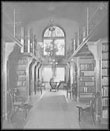
|
|
|
 |
|
 |
|
|
|
 |
|
|
|
|
|
|
|
|
|
|
Oliver Wendell Holmes (1809-94) |
|
|
|
|
|
Cambridge-born, the son of a prominent local minister and a mother descended from poet Anne Bradstreet, Oliver Wendell Holmes became the very archetype of the Boston Brahmin. (His son, Oliver Wendell Holmes, Jr., embarked on a distinguished law career that led to his eventual appointment as a Supreme Court justice.) A renowned physician and professor of anatomy and physiology at Harvard, Holmes, Sr. also had a second career as a writer -- hardly avocational, given his prolificity, his wide readership, and his book sales. His considerable output included novels, biographies (including one of Ralph Waldo Emerson, the New England Transcendentalist), and poems, among them such once-celebrated verses as "The Deacon's Masterpiece, or, The Wonderful One-Hoss Shay" and "Old Ironsides," read by millions and memorized by thousands.
In his writings, Holmes often sought, found, and elaborated on the poetic in nature and in science. Edward Weston would surely have known his meditation on a humble seashell, "The Chambered Nautilus" ("Build thee more stately mansions, O my soul . . . "). Devotees of Walter Benjamin's discussion of the fl‰neur as the quintessential urbanite observer -- a proto-photographer sans camera -- might want to read Holmes's poem "The Fl‰neur," which anticipated some of Benjamin's ideas (and perhaps provoked them) in the context of a rumination on the interconnections between yet another optical instrument (the telescope), Boston street life, and the Transit of Venus in 1882.
|
 |
Holmes also wrote numerous essays. His most famous collection of these, The Autocrat of the Breakfast-Table (1858), a set of humorous pieces, remains in print and continues to sell to this day. He wore his erudition lightly in both his poetry and his prose, becoming a familiar, trusted, and much-loved voice to the reading public of his day. Kathryn VanSpanckeren wrote of him that "[i]n his time, and more so thereafter, he symbolized wit, intelligence, and charm not as a discoverer or a trailblazer, but rather as an exemplary interpreter of everything from society and language to medicine and human nature." Today we might call him a popularizer -- if that term had not taken on some deprecatory connotations -- and a generalist.
Polymathic in his interests, both deeply and widely learned in numerous disciplines, a student of the sciences, linguistics, literature, and art, Holmes appears to have found himself drawn inexorably to contemplate photography, that astonishing new medium which emerged from the scientific and technological experiments and cultural energies of his own time. He brought to bear on it his erudition and his poetic inclinations. The quality and intensity of attention that he pays to photographic images -- including not only slow, patient, close naked-eye scrutiny but the use of magnifying glasses and even microscopes for the examination of details -- surely represents what every photographer desires from his or her viewers.
Holmes wrote and published these three related essays over a four-year span between 1859 and 1863, each of them two years apart, just before and during the Civil War. All appeared in The Atlantic Monthly, then as now a Boston-based periodical aimed at a literate, educated general audience. The first (and most frequently reprinted and cited) sketches the then-prevalent types of photographs (Daguerreotype, collodion-negative print, and stereograph, a term Holmes himself coined), and speaks evocatively of the medium's representational accuracy. The next uses the author's library of stereo cards and transparencies as the basis for an imaginary tour of Europe and the Middle and Far East. The last takes us for a visit to the New York City establishment of the E. & H. T. Anthony stereoscopic company; then into the studio of the New York portrait photographer J. W. Black, giving a step-by-step account of production from creation and exposure of the negative via wet-plate collodion through the making of the final print; goes on to consider studio portraiture as a genre; and concludes with an assessment of numerous stereo works, including western landscapes by Carleton Watkins and Mathew Brady's Antietam documentation.
His response to the latter is unequivocal: "The honest sunshine . . . gives us, even without the crimson coloring which flows over the recent picture, some conception of what a repulsive, brutal, sickening, hideous thing it is, this dashing together of two frantic mobs to which we give the name of armies." That his son was then fighting in that very war doubtless intensified his understanding of what these images represented.
In the Photography Criticism CyberArchive:
Essays
An Oliver Wendell Holmes Bibliography
A comprehensive bibliography of Oliver Wendell Holmes, Sr.'s writings can be found in Currier, Thomas Franklin. A Bibliography of Oliver Wendell Holmes, ed. Eleanor M. Tilton (New York: New York University Press, for the Bibliographical Society of America, 1953). A partial bibliography compiled by Mark Van Doren appears online at bartleby.com.
(Photo credit: "Oliver Wendell Holmes, Sr.," date and photographer unknown.)
|
|
|
|
|
|
|
|
|
|
|
|
|
|
|
|
|
|
|
|
|
|
|
|
|
Back to top
All contents © copyright 2003-05
by A. D. Coleman/PCCA
and the authors and artists, except as indicated.
All rights reserved.
info@photocriticism.com
Site design by John Alley
|
|
|
|
|
|
|
|
|
|